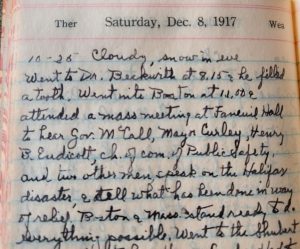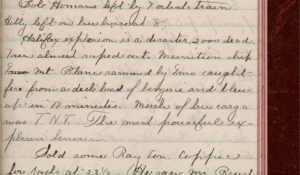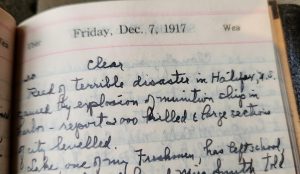by Rakashi Chand, Reading Room Supervisor
Every year there is a grand tree lighting celebration on Boston Common. While exciting and fun, it is the tree itself that embodies kindness and unity. The tree is donated by the people of Halifax, Nova Scotia, Canada to the people of Boston, Massachusetts, USA as a token of gratitude for the rescue mission that went into effect on the day of the Halifax Explosion.
An unimaginable tragedy occurred on the morning of 6 December 1917 when two ships, the Imo and Mt. Blanc collided in Halifax Harbor. The Mt. Blanc was laden with thousands of pounds of highly explosive munitions including picric acid. The ship exploded with a blinding light, sending a shockwave throughout the city that shattered windows 50 miles away. The ship dissolved to molten fragments leaving a horrific wake of disaster. Almost 1,800 people were killed and an estimated 9,000 people were injured in the explosion. Northern Halifax had been flattened and buildings across the city were collapsing or on fire. The explosion caused a tsunami that further devastated the port, city, and bay.
An hour later after the explosion, news of it reached Boston by telegraph. By 11:00 AM, Governor Samuel McCall wired the reply “Massachusetts stands ready to go the limit in rendering every assistance you may be in need of.” While many of Boston’s trained medical and emergency personnel were in Europe as part of WWI, the first relief train full of medical personnel and supplies left Boston for Halifax that night.
“At ten o’clock that night the relief train left Boston, carrying the surgeons from the State Guard, and nurses, medical and other supplies and food, all under charge of Mr. A. C. Ratshesky, and accompanied by Mr. John F. Moors in charge of the Red Cross contingent.” (1)
A blizzard paralyzed the relief train as it struggled to get to Halifax, but they persevered and immediately wired to send more supplies.
“The relief party which left Boston Dec. 6 arrived at Halifax the morning of Dec. 8, having experienced great difficulties from snow blockades, for one of the severest storms of the winter was encountered. Here they found the streets obstructed with debris and snow, and that theirs was the first medical relief party to arrive. It contained 10 surgeons from the Massachusetts State Guard, 10 nurses, 2 members of the state QMC, and members of the Massachusetts Red Cross.” (“Halifax Relief Expedition.” (1)
As soon as the train arrived in Halifax, they set up a base camp and hospital.
The Massachusetts Historical Society holds the diaries of several Massachusetts citizens who noted the Halifax Explosion in 1917.
Funds were raised by a popular subscription, people across Massachusetts contributed and gathered clothing and other necessities. A public Meeting was held at Faneuil Hall and recorded by Robert James Streeter, a history teacher, who attended the meeting.

Saturday Dec. 8 1917
“Went into Boston at 11:00 and attended a mass meeting at Faneuil Hall to hear Gov. McCall, Mayor Curley, Henry B. Endicott, ch. of com. of Public Safety and two other men, speak on the Halifax disaster, & tell what has been done in way of relief. Boston & Mass stand ready to do everything possible.”
Henry Adams, the son of Charles Francis Adams, Jr., worked in the financial heart of Boston. He recorded the news and impacts of the Halifax Explosion on two consecutive days. On 7 December, he wrote:

Friday, December 7, 1917
“Halifax explosion is a disaster. 2,000 dead. Town almost wiped out. Munition ship
ImoMt. Blanc rammed by Imo caught fire from a deck load of benzene and blew up in 17 minutes. Much of her cargo was T. N. T. The most powerful ex-plosive known.”
Georgina Lowell, whose diaries make up part of the Francis Cabot Lowell (1803-1874) Papers, records reading about the explosion in her diary:

Friday, December 7, 1917
“Read of Terrible disaster in Halifax, N.S. caused by explosion of munition ship in harbor- report 2000 killed and large sections of city levelled.”
The efforts to aid Halifax continued well into the next year. While relief came from across Canada and the northern United States, the first responders from Boston will always be remembered. Each year, the people of Halifax choose a special tree to send to Boston as a special token of the bond between the two cities. The tree on Boston Common is a quiet testament to the both the strength and kindness of humanity, and in my mind, a testament of the true Spirit of the Holidays.
- In: Commission on Massachusetts’ Part in the World War. Report of the Commission on Massachusetts’ Part in the World War. Compiled and edited by Eben Putnam. Boston: Published by the Commonwealth of Massachusetts, 1931. Vol. 1, 53-54.)
For further reading, please visit Nova Scotia Archives the 1917 Halifax Explosion Nova Scotia Archives – 1917 Halifax Explosion
For further reading on Henry Adams diary notes on the Halifax Explosion, please see our December 2017 Object of the Month.

